




Jennifer Daniel Aflac





Steve Clabaugh CLU, ChFC
Editors
Heather Garbers | Trevor Garbers
Marketing Director
Marin Daniel
For Media and Marketing Requests Contact: Heather@voluntary-advantage.com and Trevor@voluntaryadvantage.com


Jack Holder EBIS

Rachel McCarter Mercer
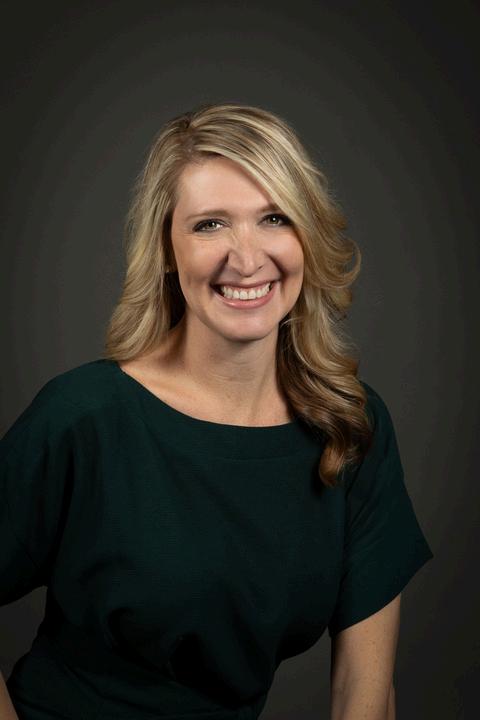
Mark Rosenthal PwC
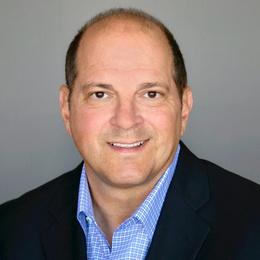
Seif Saghri BenefitHub

Tim Schnoor
Birch Benefits
Sydney Consulting Group A d v i s o r y B o a r d

Hunter Sexton, JD, MHA

Michael Stachowiak

Enhancing DEIB Through Benefits
Voices of VB - The Female Perspective
Data Exchange Doesn't Have To Take So Long
Helping Support Mental Health and Growing Families
Choosing the Right Mentoring Program – Part II

2023 Voluntary / Worksite Sales

U.S. Workers Facing Increasing Mental Health Challenges
To my pleasant surprise a few weeks ago while speaking at an industry event, a pretty neat thing happened that brought a big smile to my face Upon completing a speaking engagement, an individual approached and asked if I’d grab lunch with them to talk about the volatility of voluntary benefits. On the record, I can share it was surprisingly much more then just EBITDA accounting. For those of you that know – well, you know when it’s more than EBITDA it’s for real. It was about 20 minutes into our 45 or so minute discussion that out of the absolute blue they shared that I should really look at following “Voluntary Advantage” as it’s been a solid source for content during their industry observation process to this point. Now, at this point I didn’t know if Ashton Kutcher was going to pop out and I was being filmed on “Punked!” (Trust me, if you know Heather Garbers she’s absolutely all about setting something like this up on me) Or was this was really happening to me Yes, this just occurred So, yes both neat and rewarding for our industry and our advisory board as it really hit home that this publication is starting to make an impact in our marketplace
Trevor GarbersAs a follow-up to May’s editor’s note where I spoke on “what’s your next pivot in winning new business?” At that same industry event, I was asked the same exact question (in some form) – “What do you feel is necessary based on the current economic and socioeconomic climate to win business today?” Here is my reply – it was simple but has led to multiple measurable discussions
First, I believe we can all work at getting better at being present. We’re quickly losing the art of respect of being present both physically and mentally when engaging with a peer, client, business partner, etc.
Second, be a listener first. I’m incredibly guilty of this myself. I find myself ready with a reply even before someone is done speaking. I’ve started to watch top leaders and one common trait is their consistent and productive listening skills, followed by a respectful pause as they process prior to responding.
Third, I’ve started to ask our partners what their 2030 business plan looks like today. I’m still 0- for a lot in getting a plan back to date. One positive of our voluntary marketplace is that it’s incredibly nimble. On the flip side, it’s incredibly vulnerable as I question the overall long-term investment being placed today into our people, process, and product
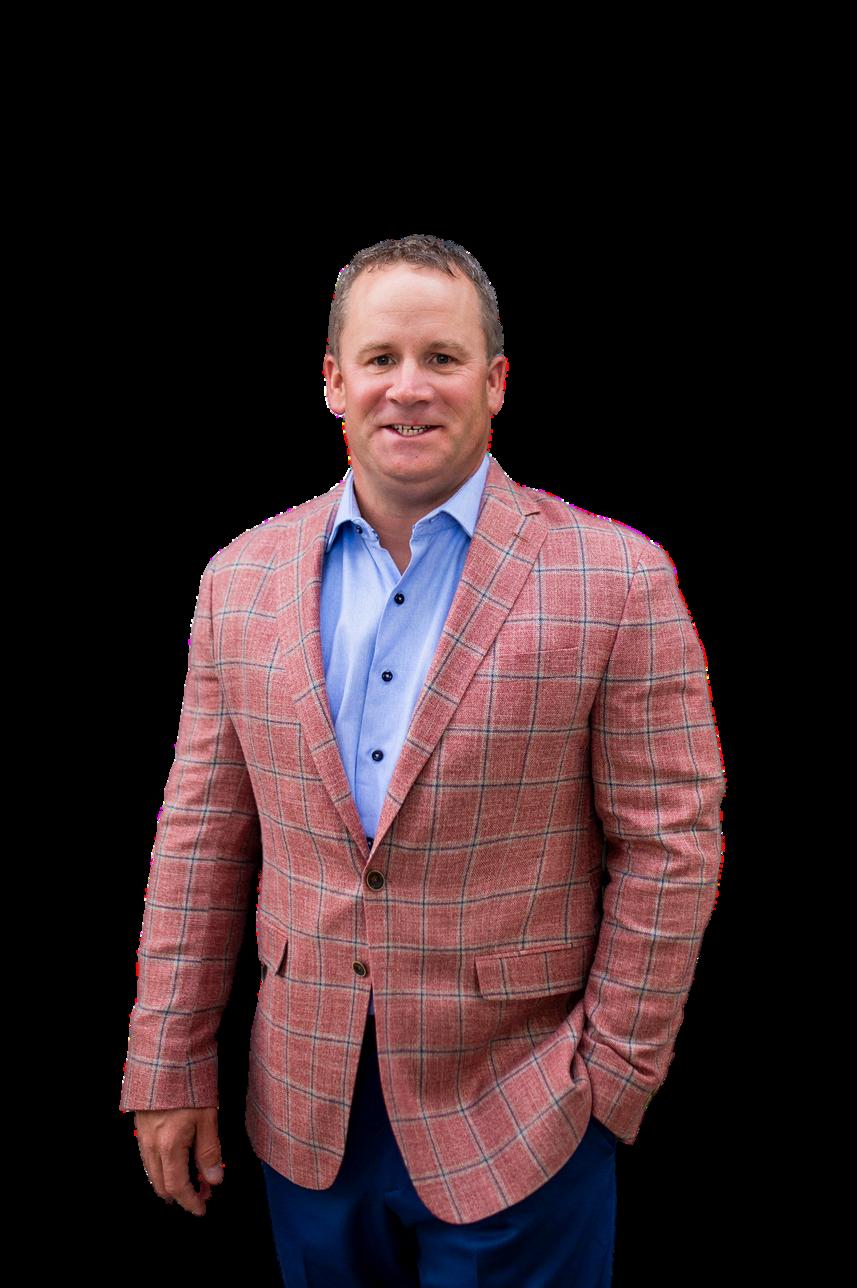
Lastly, it’s not about being red or blue It’s about being an American We are all American’s first Being different is what makes our country great A memorable compliment I recently received from a client upon leaving a meeting was they still can’t tell which side of the aisle I’m on after working together for 10 years To me, that’s the best tip of the hat this farm boy can ever receive
In closing, I’ll continue to work on my listening skills as we search for new trends and ideas to share with you in future publications with Voluntary Advantage
GO USA!




Eastbridge is the source for research, experience, and advice for companies competing in the voluntary space and for those wishing to enter. For over 25 years, they have built the industry’s leading data warehouse and industryspecific consulting practice Today, 20 of the 25 largest voluntary/worksite carriers are both consulting and research clients of Eastbridge
Nick Rockwell President Danielle Lehman Senior Consultant
Diversity, Equity, Inclusion, and Belonging (DEIB).
This is a term we hear about almost every day in the employee benefits industry as it has become a focus of many of the organizations we work with, who want to ensure that their employees feel accepted and apart of the team An organization that has put into place a well thought out DEIB strategy can see an ROI in terms of employee retention, recruitment and overall wellbeing And we know that employees who feel like they belong are happier, healthier, and more likely to work hard to support the overall mission of the organization
So, how can we help support DEIB strategies from a benefits perspective?
We can start by not treating all employees the same. Part of our value prop in the Voluntary Benefits industry is that we provide benefit options for employees to customize their employer’s benefit offerings to their unique needs.
We know that employees have unique needs above and beyond what is provided by traditional medical, dental, and vision insurance. We know that individuals have varying needs for benefits and financial protection based on their demographics (age, gender, location, income), where they are in the life cycle (single, married, single parent), and what their life experience has been (cultural differences, family dynamic)
We also know that people can purchase the same plan for different motives – for instance, some individuals may purchase a Whole Life insurance policy for the long term care rider, others because they are nearing retirement, others for the cash value component, and still others because it is an issue age product and they would like to lock in at the lower price So it’s not only important that we make a diverse set of benefits available to employees that appeal to their unique needs, but also that we communicate those benefits in a way that is easy for them to understand how they can assist them with their personal goals.
In search of how we can broaden benefit portfolios above and beyond the traditional benefit offerings, we have reached out to providers of unique benefits in our marketplace that can help support DEIB strategies. We’ve interviewed Ann Cosimano, General Counsel at ARAG; Landon Fielding, CoFounder & CEO of Brite; Howard M Gerver, President of MindBridgecare (a division of HR Best Practices); and Einat Steklov, Co-Founder & CoCEO of Kashable for more information about how their solutions are changing the marketplace
Ann - Employees regularly deal with legal events in their lives, spending their own time and money trying to resolve the issue and protect their legal rights Navigating the legal system can be a lonely and scary process –especially for employees with unique legal challenges The stress of dealing with these issues can have a significant impact on their overall well-being and productivity at work.
ARAG legal insurance helps employees and their families protect their legal rights with affordable access to valuable legal services. We break down the traditional barriers one might experience in accessing a qualified attorney (ie. cost and accessibility) and quickly connect employees to attorneys who are best fit to help them resolve their unique legal issues – from the simple to very complex Inclusivity is the founding principle of our organization - ARAG has operated for more than 85 years with the mission of providing access to justice for all Howard - MindBridgecare offers a voluntary mental wellbeing bundle through a monthly subscription for the entire household There's no cost sharing - no copay, no copayment for traditional therapy services Our programs also include: nutrition, exercise, yoga, meditation, charity care assistance and medical bill negotiation There's even a self-care library with nearly 1,500 articles, podcasts, videos, and assessment tools.
Landon – Brite is a fully customizable benefits education platform that drives strong efficiencies for brokers and HR teams. In under two hours, our platform can generate benefit guides, emails, text messages, presentations, and more, saving brokerage firms from having to invest time and resources into creating these items ad hoc
Einat - Kashable helps to provide access to Socially Responsible Credit™ and financial wellness solutions to employees as an employer-sponsored benefit. We deploy innovative technology and integrate with HRIS and payroll systems to enhance the financial wellbeing of working Americans through workplace loans and financial wellness tools and resources

How can a service like yours enhance DEI efforts within an employee population?
Landon – We understand that each employee population is unique and has varying needs We allow for consultants and HR teams to customize of our content to better address individual employee needs and embed auto-translation capabilities, decision support recommendations specific to each employee circumstance, and maintain full ADA compliance across our platform Many benefit programs include specific resources for the LGBTQ+ communities and we have created guides to help highlight and extract those details that pertain specifically to those communities
Einat - Kashable considers other factors beyond credit scores, which helps to make finance more accessible and empower employees to take control of their financial needs. Kashable lends to a diverse population that often reflects the American workforce. Sophisticated and forward-thinking HR teams utilize Kashable to advance their company's DEI strategy, highlighting the importance of financial inclusion.
Howard - DEI is much more than what's obvious to the eye - ethnicity, gender, age, and physical ability Depression, stress, and anxiety are often invisible and cannot always be detected by others Sadly, many people suffering with mental wellbeing challenges do not seek care due for many reasons Two big reasons are 1) Stigma and 2) Cost Unfortunately, many people think therapy is too expensive and are not able to spend the money
HR decision-makers believe that greater inclusion of underrepresented minorities would help across a range of issues including:
“The
State of Workplace Diversity, Equity, and Inclusion in the United States and Canada, 2023” - Culture Amp 1
Ann - Members of diverse populations and communities may face unique legal issues that are more challenging or complex than their peers Our legal insurance plans include coverage to help all employees with their unique legal situations, whether it's an employee with a disability, a veteran or a person who is LGBTQ+ or other underrepresented communities As an example, our coverage provides support for domestic partnership agreements, hospital visitation authorizations for same sex partners, gender identifier change and administrative hearings for veteran’s benefits. Having access to insurance coverage that recognizes and provides coverage for unique situations allows employees of diverse populations to feel heard and supported, so they can be their whole self at work
What type of ROI can an employer expect to see when a service like yours is implemented?
Einat - Employers implementing Kashable can anticipate a boost in productivity and an enhancement in employee attraction and retention Kashable's financial wellness program offers employees access to low-cost credit, which can help alleviate financial stress, allowing them to focus more effectively on their work Additionally, by providing Kashable, employers can demonstrate their commitment to their employees' financial wellbeing, which can enhance loyalty and retention Our research shows that engagement with Kashable improves retention; for instance, one of our clients experienced a 22% reduction in turnover among Kashable borrowers Furthermore, 76% of employees who had a loan with Kashable did not resort to taking a 401(k) loan, preventing 8,000 such loans since implementing our product.
Ann - Employees who enroll in legal insurance coverage will spend less time and money resolving legal issues and have more time to focus on their work – resulting in reduced absences and increased productivity Employees represented across different Business Resource Groups will feel like their voice is heard when a legal insurance benefit is offered with coverage that supports their unique needs This can lead to an increase in overall employee satisfaction and retention.
Landon – You will see an ROI from a few different standpoints. Our two primary focus areas are ensuring our consultant partners save valuable time creating communication materials inside Brite, while providing an enhanced experience for employees during OE and throughout the year. Next, due to the increased education and confidence that employees feel when electing benefits, we drive strong participation increases in all products offered, including voluntary lines of coverage that tend to get less education focus during enrollment season.
Howard - Naturally, along with a clearer mind comes higher productivity, lower absenteeism, fewer workers' compensation and disability claims Lower turnover is also a wonderful benefit of having a workforce with fewer mental health-related challenges Even better, since MindBridgecare is a voluntary program, the ROI is super compelling! Together, we can help make the world a better place while helping America's employees and their families
Ann Cosimano, General Counsel, ARAG - directs the company's legal, regulatory, compliance, risk management, and attorney relations departments. Having started her career as an attorney for nonprofit organizations, Ann brings a full understanding of - and deep respect for - members experiencing legal issues Ann is a member of the Polk County Women Attorneys, Polk County Bar Association, Iowa State Bar Association, American Bar Association and the Association of Corporate Counsel

Landon Fielding, Co-Founder & CEO, Brite - After a successful career on both the carrier and brokerage sides of the employee benefits industry, Landon co-founded Brite in 2019. Leveraging technology, Brite was built to create a robust suite of benefit communication resources at the click of a button.
Howard M. Gerver, President, MindBridge.care, a division of HR Best Practices - is a mental health champion and is also the founder of TheAdamProject.org, a curated directory of mental wellbeing self-care resources and HR Best Practices, a data-driven healthcare cost containment firm specializing in eligibility and claim audits Prior to starting HR Best Practices in 2001, Howard worked for leading consulting firms including Price Waterhouse and Mercer HR Consulting


Einat Steklov is the CEO and co-founder of Kashable – co-founded Kashable in 2013, to help transform the way working Americans access credit. Under Einat's leadership, Kashable has raised $200M in equity and debt capital, and has partnered with more than 250 companies to provide thousands of employees with financial health, wealth and financial wellness tools.




Date: June 27, 2021
Time: 11am PT / 12pm MT / 1pm CT / 2pm ET

Artificial Intelligence (AI) is everywhere. Everyone talks about it. Every company asks about it. But what does AI really mean for employee benefits?
Join us for an enlightening session with industry leaders who build and use AI technology daily We'll break down the real-world applications of AI in the benefits industry, discuss what's happening now, what's on the horizon, and what's still just science fiction.
What exactly is AI
The current state of AI technology
How AI is transforming the employee experience through personalized communications, decision support, and timely claims reminders
How AI can reduce workload for account managers by automating repetitive tasks like benefits guide creation and answering employee questions
How carriers can leverage AI to improve member experience and utilize data analytics
The financial benefit of AI: cost savings, new business opportunities, and increased participation
The future of AI


Coming out of the pandemic, more workers are experiencing mental health challenges including anxiety, difficulty managing stress, depression, relationship or family conflicts, grief or loss, alcohol or substance abuse, thoughts of suicide or other mental health conditions.
According to LIMRA research, 75% of workers say they have experienced at least one mental health challenge either “sometimes” or “often” during the past year, with 37% struggling with mental health issues “often.”
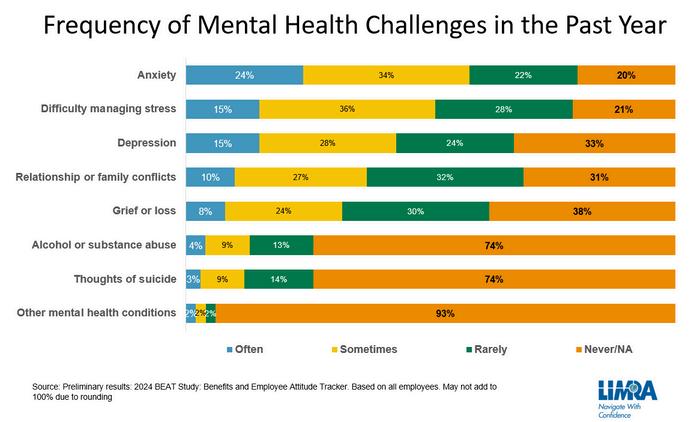
The research shows the mental health crisis is even more prominent among the younger generations, with 91% of Gen Z workers saying they have struggled with mental health issues at least “sometimes” during the past year, while 62% struggled “often.”
Beyond the negative effects on employee wellbeing, mental health struggles can be an issue for employers as they are associated with decreased workplace productivity and increased absenteeism and presenteeism In addition, according to the mental health services provider ComPsych, employee leaves of absence for mental health issues are up a staggering 300% from 2017 to 2023 A leave of absence, ComPsych noted, can vary from a few days to weeks
In addition, the research indicated that employees who face mental health challenges are less inclined to stay with their current employers, impacting workplace turnover.
Most workers expressed interest in having their employers provide benefits or resources to help them cope with mental, emotional, or behavioral health challenges. Almost half of the workers surveyed (49%) said they are “very” or “extremely” interested in these, while only 11% are not interested at all
Interest in mental health benefits is particularly high among younger workers, Black and Hispanic employees, members of the LGBTQ+ community, more educated workers, and those with higher job levels
Employers looking to offer more benefits in support of mental health have a variety of potential offerings to choose from and will want to prioritize those benefits that provide the most value to employees
Of possible offerings, workers express the most desire for paid time off to deal with stress or mental health issues.
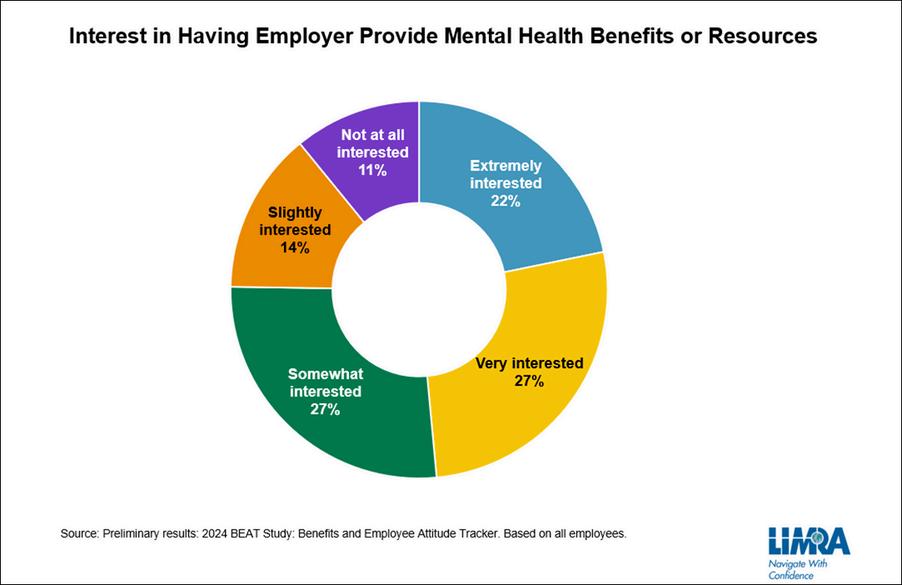
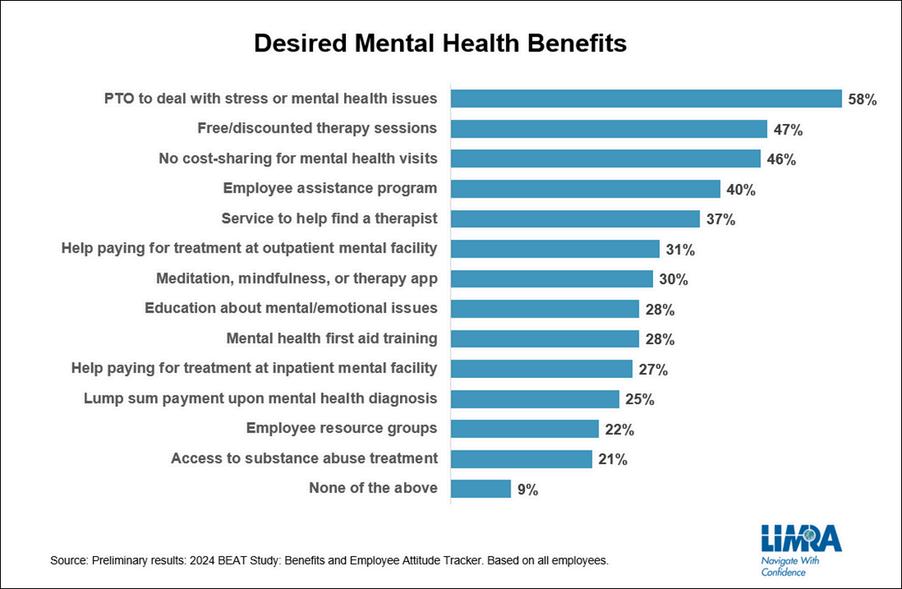
“This points to a demand for ‘mental health days,’ but this need might also be addressed through short-term disability insurance under some circumstances,” says Kim Landry, associate research director, LIMRA Workplace Benefits Research “There is also a lot of interest for access to free or discounted counseling/therapy sessions or to have mental health appointments covered by health insurance with no cost-sharing, which indicates that employees are primarily looking for help with the time and cost of dealing with mental health issues”
The study found about 3 in 10 workers are interested in benefits that help pay for treatment at an inpatient or outpatient mental health or substance abuse treatment facility, such as a hospital indemnity plan might do. One quarter are also interested in a benefit that provides a lump sum payment upon the diagnosis of a mental/emotional health condition, such as a critical illness product might offer
There is clearly a significant need for mental health benefits Employers that want to help workers and their businesses should be looking for benefit solutions to support employee mental health, as well as carriers that are working to introduce new offerings to address this demand May marks Mental Health Awareness Month a time to raise awareness of and reduce the stigma surrounding behavioral health issues, as well as highlight the ways in which mental illness and addiction can affect all of us
Originally published on LIMRAcom
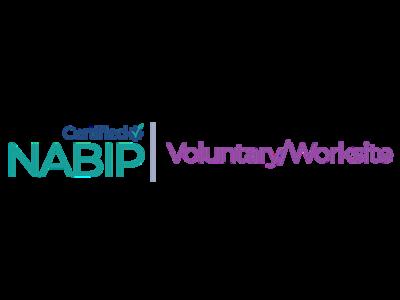

VoluntaryAdvantagehaspartneredwithNABIPtoupdatetheirVoluntary/WorksiteCertificationand itisliveandavailabletoyou24/7virtually.
ThecostoftheVoluntary/WorksiteCertificationcourseis$304.70forNABIPmembersand$401.50fornonmembers,whichincludesonlineinstructioninthreeone-hourwebinarmodules,afinalexamand continuingeducationcredits.Uponcompletion,youwillreceiveacertificateofcompletionas voluntary/worksitecertified.
CourseHighlights:
Mastertheproductwithinnovativesolutions
Understandcontractdifferences
Reviewimplementationandadministration
Obtaincrucialcomplianceinsights


We have come a long way as a society in terms of the rights and respect for females in the workforce today. However, inequalities still exist:
The #MeToo movement drew attention to the rate of sexual harassment that still persists today
According to the ACLU, on average women make 78 cents for every dollar that men earn today
According the “Women in the Workplace 2023” report from McKinsey
Only 28% of C-suite executives today are female
Due the gender disparity in early promotions, men end up holding 60% of manager-level positions in a typical company, while women occupy 40% With men significantly outnumbering women, there are fewer women to promote to senior managers, and the number of women decreases at every subsequent level.
How does the benefits industry fare when it comes to women in the workforce? Who better to ask then females in our business today. We asked leaders from across the industry “What is it like to be a female in the benefits industry today? How does that compare to when you started in the industry?” and here is what they had to say

"There'ssomethingsospecialaboutawoman whodominatesinaman'sworld.Ittakesa certaingrace,strength,intelligence, fearlessness,andthenervetonevertakeno forananswer."
Rihanna Singer&Businesswoman“Iwantlittlegirlstobelieve thattheycanbeCEOs.”
PayalKadakia CEOandCo-Founderof Classpass
As a young female in the benefits industry, I feel so much more empowered today than I did when I began my career 10 years ago. Age and experience are certainly two key factors that have contributed to my confidence, but I also no longer feel like a minority being a woman in this industry.
There is no shortage of women I can look to in Sales and Leadership roles for mentorship, and when I attend industry events regionally and nationally, I almost always leave inspired by women who are running their own organizations and have forged their own paths. I see confident, successful, powerful change makers who are leading the way with authenticity, vulnerability, empathy and a genuine desire to make an impact on the clients and teams they are serving. I see women who aren’t afraid to raise their hands and make their voices heard, even in those occasions where they are the only female on a panel. I see women lifting other women up, sharing ideas, forming partnerships and making conversations less about the challenges of being a woman and more about the reasons to celebrate each individual contributor and leader for the value they bring to the table, regardless of gender. I see women like me who are driven, ambitious and passionate, and who have a hunger to drive change and truly act as forces for good through our work.
I started in the industry in 2014 as an intern for the Worksite Sales team of a local carrier. When I was hired as an intern, I didn’t realize that insurance was such a male-dominated industry, especially in Sales and Leadership roles. By the time I accepted a full-time position with that same team, I had gained some insight into the industry through the team I worked under and several of the brokerages I was able to interact with by shadowing my Sales counterparts and mentors.
The company I was working for had multiple females in Sales roles, and some of them were amongst the top reps on their teams and were very successful in their own right. The impression I had developed by that time was that this was not the norm in the industry; females were more often seen in Account Management and back-office roles and could potentially work their way up to consideration for a producer role if they showed real ambition. It seemed to me that, at many brokerages, there was a “good old boys” mentality, and men were primarily the ones responsible for running agencies, making key decisions, and building and maintaining relationships with carriers and other potential business partners.
I think women have made incredible progress in this industry over the last 10 years, but we still have significant progress to make! I would love to see more women in top leadership roles at carriers, large brokerage houses and tech and service providers.
Signed - Changing the Game

Iamveryfortunatetohavefoundacompanythatvaluesmeforme,butIstillfeellimitedtoprofessional growth. Whether it is within the VB industry or at my company, I still feel that women have to really fight to get a seat at the table. Very rarely when I go to corporate functions, whether it is within the industry or my own organization, do I see a woman on the Executive level panel. It can be very dishearteningtonothaverepresentationatthetopoftheladder,asitmakesmewonderifIcouldever get there or be considered. While we have many women leaders, none of them are at the top of the corporatechain.Ihavetoaskwhy?
While leadership roles have expanded for women, the one thing that has greatly changed is the toleranceforsexualharassment.Ihavebeenworkinginthebenefitsindustryfor20years.Earlyonin mycareer,Ifieldedmanyunpleasantencountersandevenoncehadaclienttrytokissme!Itisclear thatnewboundarieshavebeensetforhowtotreatyourco-workersandbusinessassociates.Thereis certainlylesstoleranceforthiskindofbehavior,whichbeginstolevelouttheplayingfield.

Thefactthattherearemorefemalesinthebenefitsindustrymakesiteasiertobeasuccessfulwoman inthisindustrytodaythanitdid20yearsago.It’sgreattoseeallthefemalepracticeleadswithinthe majorbrokeragehousesandhowtheyaredrivingbigbusiness.Womensupportwomenandthat’smore evidentthaneverbefore.

However, the old boys network still exists in this industry. Look at all the award event pictures on LinkedIn…theyaremainlyofwhitemenwinningawards.Whilementrytobeinclusive,theystillmainly plannetworkingeventsaroundsportingevents,golf,cigars,hunting,etc.Notthatwomendon’twantto attend those events, but they aren’t usually designed with women in mind. When speaking to other female leaders, a common theme is that they are the closers, the ones that are brought in when the businessisontheline,whenit’stimetoclosethedealortopartnerwithaclienttofixthingsandsave the relationship. Whether it’s their ability to multi-task, their empathetic approach, their in-depth industry knowledge, the desire to learn and grow or the passion they feel for taking care of their clients…womenaremakingadifferenceandyouwillcontinuetoseemoreofthemasPresidents,sales leaders and difference makers in our industry. My personal focus is to mentor young women in the industryandhelpthemseehowsuccessfultheycanbeinthisindustry.
Signed-GolfGirlWhenIfirststartedintheindustry,Ifeltverymuchlikeitwasthegood‘oleboysclub.Businessdoneon thegolfcourse,beersafterwork,andbusinessdriventotheguysthattheydothoseactivitieswith.I rememberwalkingintotheofficeofasmallagencyinNorthCarolina16yearsasarookiesalesrep,and theownerofthisagencyliterallysaidtome“honey,whyareyouworking?Youshouldbebarefootand pregnantinthekitchen!”.Inthatmoment,Ididn’tfeeldefeated,butratherinvigoratedtobemorethan justawoman,buttobethebestrephe’deverworkedwith.
Fromthenuntilnow,ourindustryhasmadegreatstridesindiversifyingandbringingfemaletalentinto the fold. Many of our customers in HR are female, so it’s a natural that those consulting and selling benefit plans should be represented too. Being a female in this industry now is not an anomaly, and manyofthemostsuccessfulconsultantsandrepsthatIhavecomeacrossinmycareerarefemale.

WhenIstartedinthisindustry15yearsago,Iknewthatmyyouthwouldworkagainstme,butbelieved thatIcouldbuildareputationandmoveupthecorporateladdersolelybyhardworkanddrive.Today,I dobelievethatwomenarestillheldbackandthatwehavetofightforourseatatthetable.
WhenIstartedmycareer,Ididn’trealizeuntilIlookedbackthatIwasoneofonlythreefemalesales repsacrossthecountryatatop10carrier(outofabout100employees).Ineversaid“no”togoingthe extra mile or helping someone else out, traveled on Sundays, getting home late Friday night, outproducedtherestofmyregioncombined,butwaspassedoverforpromotionsmultipletimes–once evenafterIwasrecommendedforthepositionbythepersonleavingtherole.ItwasnosurprisethatI leftthecompanyshortlyafter.
Today, I have a male business partner and have had vendors completely ignore me, only directing “business talk” to him or solely asking him what events he would like them to take him on when I’m sittingrightnexttohim.Weareequalpeersbutthefactthatheisamangiveshiminstantcredibility, whileIhavetobuildmine.I’veevenbeentold,“Doyouknowwhyyouaresuccessfulinthisindustry? Youarelikeadude”,IwassoshockedbythatstatementIdidn’tknowwhethertolaughorcry.

I see sales reps present to prospects every day and only make eye contact or direct questions to the menintheroom,andthenwonderwhytheydidn’tgetthebusinesswhenthefemalewasthedecision maker.Ihearfromsalesrepsthatarefrustratedthattheycan’tgetbusinessfromsomeonewhenthey takethemaleexecutivegolfingeveryweek–ignoringthefemalethatisactuallymakingthedecisions. Andladieswedothistoo.Weevencuteachotherdownandholdeachotherbackattimes,whenwe couldbebuildingeachotherupandhelpingeachothersucceed.
Idofindthatwhenwomenandmenareonthesameteam,theresultsaremuchbetter.Wehadvendors presenttousinamultipledayeventandsurveyedattendees(menandwomen)afterwardstoratethe meetings. Every presentation that had females involved scored at the top, and the presentations that were conducted soley by men (most also wearing a white collared shirt and blue suit jacket like a uniform)scoredatthebottomintherankings.
I don’t believe that females are held back on purpose – many people are just more comfortable promotingorhiringpeoplethatlookorthinklikethem.Uniqueperspectivesdriveinnovationandwe canallworktoidentifyourownunconsciousbiasandfindwaystoovercomeit.Forinstance,whenI’m inameeting,Imakeaconsciousefforttowelcomeeveryonethatenterstheroomandengagethemin botheyecontactandtheconversation.Itstartswitheachoneofus.
Signed-StillFighting
“Don’t ever buy into the belief that you need to behave like a man to succeed. Instead, embrace all of the unique qualities of your personality and bring this into business with you.”Hulya Mantion Founder and CEO of CircleHood
“Don’tbeintimidatedbywhatyou don’tknow.Thatcanbeyour greateststrengthandensurethat youdothingsdifferentlyfrom everyoneelse.” SaraBlakely FounderofSpanx

Inmyexperienceitalldependsontheseatyouoccupyatthetable.IfafemaleisintheHRseatithas alwaysbeenandcontinuestobearoleofpowerandesteem,respected.Butifyou’vefoundyourselfin thecarrierreporbrokerseat,whatstartedasanuphillclimbcontinuestobechallenging.Anditshows upinamyriadofways.Itcanbeasupervisortalkingforyou,downtoyouortakingcreditforyourwork inameeting,allthewaytotheextremeofhavingtothrowyourselfacrossaconferenceroomtableto boltawayfromalecherousadvanceinthebroadofdaylight.Perhapsthemostcomedicincidentwas beingtoldrecentlythatamonkeycoulddomyjob&nowbecauseAIcandosomanythings,theironyof thatstatementjustticklesmyfunnybone.
Theseareallthingsthatwewouldbehardpressedtoseehappeningtoourmalecounterparts.Weare stillpaidsignificantlylessthanourmalepeersforthesameworkandtitle.Morerecently,Ihaveseen womenhelpingotherwomentoriseintheranks,andthisgoesfartopromoteequality,buttheopposite still is true where once a woman is in power there is a scarcity mindset and other women are not welcomed.Menneverseemtoactinthissamefashion.Ifyoulookaroundtherearestillfarmoremales inleadershiprolesthanwomenacrosstheindustry.
Signed-MartyMcFly,BacktotheFuture
“When I'm sometimes asked when will there be enough [women on the Supreme Court] and I say, 'When there are nine,' people are shocked. But there'd been nine men, and nobody's ever raised a question about that.”
Ruth Bader Ginsburg Supreme Court Justice“Eachtimeawomanstandsupfor herself,withoutknowingit possibly,withoutclaimingit,she standsupforallwomen.”
MayaAngelou
Author,Poet,CivilRightsActivist.
I still ask myself and talk with colleagues…What should I wear to this meeting? Business or business casual? Will I appear too formal or too casual? Will my attire affect how seriously I'm taken? These questions have plagued women for decades. Back when I entered the benefits industry 32 years ago, women were restricted to only wearing skirts or dresses and pantsuits were frowned upon. This restriction seemed archaic, even in the early nineties. While pantsuits for women gained acceptance in the 1960s and 70s, it wasn't until the power-dressing era of the 1980s that they truly became a symbol of female empowerment, often boasting strong silhouettes with shoulder pads. Despite the fashion industry's rapid changes, the insurance industry lagged behind. However, progress persists, and we are here taking action to drive change.
Signed - WardrobeShift
Starting my career in the benefits industry was a bit unconventional because I began in Finance at a hospital. My role involved programming insurance contracts into the hospital's financial system, which gave me an in-depth understanding of insurance early on. Over the years, my career has come full circle.
One of my most unique experiences as a female in this industry happened while I was at a brokerage. As part of the rigorous process to become a Senior Vice President, I had to present my business case to our executive team. This meant standing in front of 12-15 leaders, a scenario that is inherently intense and nerve-wracking. At the time, I was almost eight months pregnant. I couldn't fit into a suit, my feet were too swollen for heels, and standing comfortably for two hours was out of the question! Despite these challenges, the executive team was incredibly supportive, and the presentation went well. To top it all off, I gave birth the following week!
Being a female in the benefits industry today is both challenging and rewarding. It's easy to get discouraged by the lack of female leadership or feel excluded from the proverbial boys' club. However, I've come to appreciate the unique strengths I bring to the table as a woman. In the voluntary benefits sector, where emotional connections to products drive sales, I excel at creating these ties better than many of my male counterparts. I also relate exceptionally well to my team, fostering connections that drive our success. When making tough decisions, I consider the emotional impact on our team and how we can support those affected.
Early in my career, I felt self-conscious about being a wife and mother, fearing it would hinder my professional image. Now, I realize that my role as a mom enhances my capabilities in the boardroom. I connect with various generations and understand the challenges young moms and early-career team members face. My firsthand experience with how insurance affects families is invaluable. After all, our industry is fundamentally about protecting families, and that perspective is crucial.
Overall, being a female in the benefits industry today is about embracing our unique perspectives and leveraging them to drive success. While the industry has its challenges, the progress and the opportunities to make a meaningful impact are incredibly fulfilling.
If you are an executive leader at your organization, go to your website and take a look at the pictures of the management team. How many women are there? Do you see younger perspectives or different ethnicities represented? If everyone looks the same (except for the VP of HR), you may need to rethink your hiring practices and identify if your workplace is truly inclusive to everyone - ask yourself, how did each of these people get their roles, and while you are at it, audit if there is wage parity amongst your workforce. A 2019 McKinsey report revealed that companies with more women in executive roles generated 21% higher profitability. Women do not want to be promoted just because they are women to check a box for the organization - they just ask for a level playing field to work their way up in an organization
And women – we should be helping to bring each other up, mentor the next generation, and collaborate We also need to have the confidence to demand more for ourselves– ask for the raise, ask for the promotion and know that you deserve it You are not alone
Author’s Note: I just finished reading “Tread Loudly” by Kristine Cherek - if you would like an in-depth look from someone outside of our industry on the environment for women in the workplace, I suggest adding this book to your summer reading list
Signed - Making Lemonade Out of Lemons
Traditional data exchange methods do little to ease the voluntary benefits experience for brokers, clients, and carriers. In fact, most of the time, clients and brokers must deal with long enrollment processing times and other delays caused by the archaic data exchange systems of their carrier
Wellfleet Workplace is committed to creating efficiencies wherever possible, using technology to simplify and improve the voluntary benefits experience for clients and brokers Their approach results in: Faster enrollment
· More accurate data transfer
· Near real-time updates
Everyone in the business world understands the pains of inefficiency Whether it’s the slow internet speed, non-mobile-friendly websites, or lagging response times, lack of efficiency can lead to headaches and decreased productivity
In the world of voluntary benefits, inefficiencies often emerge in the data intake process. When a client sets up their benefits with a VB carrier, the data transfer process can often take months to complete. This can slow down enrollment and cause delays in receiving coverage.
Additionally, carriers with less-than-optimal technology often have stringent file specifications, resulting in the client needing to spend hours translating data to the correct format before it can even be sent to the carrier.
Too often, brokers and clients are left at the mercy of carriers’ outdated systems, having to put up with delays simply because that’s the way it is But not anymore With today’s advanced technology, carriers have no excuse for not getting up to speed with more efficient data intake processes that make enrollment smoother for clients and brokers
Now that you have a clear picture of the pain points associated with data intake, it’s time to dive deeper into the reasons for these challenges Why does the data intake process take so much time with many carriers?
The primary reason is outdated technology. While many industries have kept up with the current technologies, voluntary benefits carriers have often lagged, relying on systems and technologies that were built decades ago.
These old systems require a significant amount of finagling to function within today’s tech age
Additionally, carriers use different systems for different purposes, creating a disconnect that must be overcome For example, a carrier may use one system for enrollment, another for claims, and another for billing Therefore, passing client data to all these systems can take extra time and effort
That’s why Wellfleet created a single system to manage everything from enrollment to claims, making data available across the whole system Furthermore, many carriers rely on only electronic data interchange (EDI) files to load information into the chosen benefit administration systems. EDIs allow data to transfer from one party to another, but the process can require a great deal of manual effort to enter, test, and validate it correctly. For example, traditional data transfer during enrollment can take weeks to months to complete and include countless phone calls, emails, and headaches
There is a better way to do data intake between the client and VB carrier When carriers use modern technology to transfer enrollment data, the process can take significantly less time For example, instead of using only EDIs, the enrollment process can take far less time if carriers use application programming interfaces (APIs) to transfer their data With APIs, a oncetedious task happens in near real-time
APIs also transfer information between the client and carrier However, they don’t require batched manual input, and they minimize completion time
What used to be a painstaking process of batch data transfer vulnerable to transfer delays and the inability to personalize engagement and interactions with the employee is now a nearly immediate line of communication thanks to APIs
Learn more about how APIs are transforming voluntary benefits in our whitepaper
In addition to faster technology, clients and brokers also benefit from no longer having to submit files with certain requirements to the carrier. With Wellfleet, clients can send the necessary enrollment data in any file format, and our system will translate that data for them. That means less time the client must spend getting the files right.
Because of these technological advances, our systems shorten the data intake process from months to weeks or even days
As most VB brokers know, the easier and faster the client experience, the more satisfied they are That means fewer phone calls, less stress, and happier clients If for no other reason, that’s why you should choose a carrier that’s optimizing data intake technology.
Learn more about how Wellfleet Workplace can simplify your workplace benefits experience. Connect with our team to see how our customized plans can benefit your clients.
Prudential Group Insurance

estimated that 1 in 5 couples will struggle with infertility, with the costs often a major barrier to family building Add to that rising healthcare costs and the associated medical bills that can add up quickly when it comes to expanding a family, with nearly 20% of individuals struggling to pay medical debt related to childbirth.
As part of Prudential Group Insurance’s expanded suite of Critical Illness and Hospital Indemnity insurance, the new mental health benefits include screenings for anxiety, mood disorders and substance abuse as well as coverage for the most diagnosed mental health conditions and severe mental illness The expanded family benefits include coverage for surgical and non-surgical procedures, prenatal care, childbirth, and expanded hospital stays for newborns.
According to a recent study, about 75% of U.S. adults worry about being able to afford unexpected medical bills, with about half saying they couldn’t pay for a $500 charge that wasn’t covered by insurance
Employees turn to their employers for benefits that can help them during key life events, and supplemental health insurance can pay a lump sum benefit when it’s needed most, helping employees cover unexpected medical expenses.
Visit prudentialcom/employers/group-insurance/products/voluntary-benefits for more information on Prudential’s Supplemental Health solutions
Group Insurance coverage is issued by The Prudential Insurance Company of America, a Prudential Financial company, Newark, NJ
Prudential, the Prudential logo, and the Rock symbol are service marks of Prudential Financial, Inc and its related entities, registered in many jurisdictions worldwide

Last month we introduced the discussion about how to choose the right mentoring program for an organization We focused on the purpose, desired outcomes, length and benefits of the program This month, let’s take a look at the process of selecting both mentors and mentees These choices are built on your answers from last months’ article
For a business team, as with any sports team, it is as important to choose the right coach (mentor); as it is to select the right members of the team The selection process needs to produce team members with the “capacity for a near perfect performance” and the temperament to trust that the leader and other team members are committed to acting in the best interests of the team. The mentor needs to possess a deep knowledge of the subject being taught and to have the skills necessary to bring out the best in each member and the team as a whole
It seems obvious that the person chosen to be a mentor should be a subject matter expert in the subject(s) they are mentoring But it’s a temptation to stop there in the selection process A good mentor also must be the type of person who can take joy in seeing others succeed Unfortunately, it is not uncommon to see an outstanding employee placed in a leadership role when their strength is in producing and not mentoring Outstanding performers do not necessarily make outstanding mentors if their internal drive is motivated by personal success over celebrating the success of others Here is an example:
Alex is an exceptional employee, known for his technical expertise, problem-solving skills, and ability to deliver complex projects on time. He is highly valued for his contributions and consistently receives top performance reviews.
Alex's outstanding performance has made him a prime candidate for promotion to a leadership role focused on mentoring newer associates The promotion is intended to leverage Alex's technical skills to guide and mentor others Unfortunately, Alex is motivated by personal achievement and recognition for his many accomplishments Guiding new associates in achieving their goals and then recognizing their accomplishments is not really of interest to him His employer promoted him to the position in spite of his conflicting priorities.
This has led to some pretty serious challenges in the organization and development of his new team.
Micromanagement: Alex tends to micromanage the team, unable to trust others with critical tasks. This behavior stifles the team's creativity and autonomy, leading to decreased morale and productivity
Poor Delegation: Alex struggles with delegating tasks, often opting to just do the work himself to ensure quality This results in Alex becoming overwhelmed with the workload, while team members feel underutilized and undervalued
Lack of Communication Skills: Alex's communication style is direct and technical, lacking the softer interpersonal skills needed for effective team development. Miscommunications and conflicts arise, as team members find it difficult to understand expectations and feedback.
Inability to Provide Constructive Feedback: Alex is not comfortable providing constructive criticism, either avoiding difficult conversations or being overly critical. Team members are not receiving the guidance they need to improve, leading to stagnation in their professional development
Focus on Work Over Leadership Responsibilities: Alex prioritizes technical work over leadership duties, such as team development, strategic planning, and stakeholder management The team's progress suffers from a lack of clear direction and support from Alex as their leader
Conclusion: Alex is an example of a high producer who excels in their technical role but faces significant challenges when transitioning to a leadership role Their struggle to adjust to the new responsibilities highlights the importance of recognizing that the skills needed for individual contributor roles differ significantly from those required for effective leadership
Instead of simply choosing the best performers to be mentors, if it’s not in their skill set, make sure to celebrate their noticeable strengths. During the process of choosing the right mentor observe the individual’s interactions with managers, peers and subordinates. The best mentors can be found helping others do better, often without being asked, because it’s in their nature. It is important to remember that success is not likely if you’re trying to change someone’s basic nature.
For many, if not most of us the job is what we do to make a living As some sage suggested long ago, “most of us work to live but some of us live to work” In our modern society work-life balance is finally getting the recognition it is due We have promoted the admiration of the workaholic to the detriment of the individual, their spouses and families
Even so, there is an observable quality in employees who are interested in learning the business, improving their ability to contribute to the organization’s success and not just doing what they must to earn a paycheck. When choosing individuals to be mentees look for those with the “capacity for a near perfect performance” and the interest in improving that capacity. As a general rule, these employees stand out in such a way that they are not hard to spot.
An ideal candidate to become a mentee exhibits certain characteristics and traits that show their potential for growth and readiness to learn Consider the case of a young professional named Jamie who is currently the Marketing Coordinator for a mid-sized tech company Here are some of the traits she exhibits that have led her manager to consider her for a formal mentoring program in preparation for likely advancement to a higherlevel position
Eagerness to Learn: Jamie consistently seeks out new learning opportunities and stays updated on the latest marketing trends and technologies. She regularly attends webinars, reads industry blogs, and takes online courses to enhance her skills.
Receptive to Feedback: Jamie is open to constructive criticism and actively seeks feedback to improve her performance
Proactive and Ambitious: Jamie takes initiative in her work and sets ambitious career goals She proactively suggests innovative marketing strategies during team meetings and has a clear five-year career plan outlining her aspirations to become a marketing manager
Strong Work Ethic: Jamie demonstrates dedication and commitment to her role She consistently meets deadlines, goes above and beyond in her tasks, and is known for reliability and thoroughness.
Positive Attitude and Resilience: She maintains a positive outlook and shows resilience in the face of change. When a marketing campaign does not perform as expected, Jamie analyzes what went wrong, learns from the experience, and applies those lessons to future projects
Good Communication Skills: Jamie communicates effectively with colleagues, managers, and clients She is articulate in presentations, listens actively during meetings, and writes clear, concise reports
Team Player: Jamie works well in a team environment and supports her peers She often volunteers to help teammates with their projects and collaborates seamlessly to achieve common goals
Goal-Oriented: Jamie sets specific, measurable, achievable, relevant, and timely goals. She sets quarterly performance targets for herself and tracks progress regularly.
Jamie’s eagerness to learn, openness to feedback, proactive nature, and strong work ethic make her an ideal candidate for mentorship Her positive attitude, effective communication skills, and team spirit further enhance her suitability Jamie is motivated to grow professionally and personally, and actively seeks guidance to navigate her career path
If the mentoring is in preparation for a possible promotion, where there are specific skills to be developed, the length of the program can be more specific. It may also be tied to the urgent nature of filling a key role in the organization so, of necessity, a hard timeline is required. Mentoring that is designed to impact a team or organization’s culture may be ongoing without a specific end date. Culture driven mentoring by nature can continue, with needed updates and modifications, over time as new employees join the organization
If the mentoring is for a specific purpose (promotion, special project, new team, etc), it will most likely be more successful in a one-to-one context As a culture driven program it may be more effective in a group context
None of us are an island unto themselves and none of us are exempt from influencing the lives of others We need to remember these two key facts
Everyonehasmentors–(whoisinfluencingyou?)
We have all been influenced (mentored) by certain people we have interacted with in our lives. Parents, grandparents, coaches, teachers, friends, bosses, spouses and others have imprinted us with views about how to live, work and play with others. As we become aware of the influence of others it is incumbent upon us to think about and choose carefully who we allow to impact our attitudes and behaviors.
Everyoneisamentor-(whoareyouinfluencing?)
Haveyoueverhadtheexperienceofsomeonetelling you that something you said or did long ago changedtheirlifeinameaningfulway?Andyoumay not even be aware of the incident they are referring to. Just like we are continually being mentored by others,soalso,areweinfluencingothers.
Mentoring represents the third of four steps in the process of building and leading a high-performance team: after establishing the standards of championship team behavior; choosing the team’s members and finally leading to the development of a meaningful action plan. The entire process leads to what we call a Relational Leadership culture.
As always, feel free to contact me to learn more about how your employer clients can benefit from the principles of relational leadership
Steve Clabaugh, CLU, ChFC - started his career in insurance as a Field Agent, moving on to Sales Manager, General Manager, Regional Manager, Vice President, Senior Vice President, and President/CEO. A long time student of professional leadership, Steve created the Relational Leadership program that has been used to train home office, field sales associates, mid-level managers, and senior vice presidents


Select
Implement
Develop
Determine and implement the
Achieve ongoing